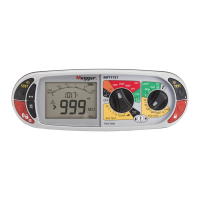3
Appendix A – Sending, Storing, Deleting and Recalling Test Results .....................................................................................................33
Appendix B – Downloading data using Bluetooth® .............................................................................................................................35
Appendix C – Installation category definitions .....................................................................................................................................36
Appendix D – Safe working practice ....................................................................................................................................................36
Appendix E – Cleaning and maintenance ............................................................................................................................................37
Appendix F – Earth resistance testing – Basic principles .......................................................................................................................37
General Specification ..........................................................................................................................................................................38
Repair and Warranty ...........................................................................................................................................................................41
G SAFETY WARNINGS
Safety warnings and precautions must be read and understood before the instrument is used. They must be observed during use.
n The circuit under test must be switched off, de-energised and isolated before test connections are made when carrying out insulation
and continuity tests.
n Continuity of protective conductors and earthed equipotential bonding of new or modified installations must be verified before
carrying out an earth fault loop impedance test, RCD or earth testing
n Do not touch circuit connections and exposed metalwork of an installation or equipment under test. Under fault conditions the
system earth could become hazardous live.
n Do not touch the earth stakes, test leads and their terminations (including connections to the earthing system under test) if an
installation earth fault can arise unless adequate precautions are taken.
n The ‘live circuit warning’ and ‘automatic discharge’ functions are additional safety features and should not be regarded as a
substitute for normal safe working practices.
n Do not move the rotary switch positions while a test is in progress.
n Do not operate the instrument or connect it to any external system if it shows any visible signs of damage or if it has been stored
for prolonged periods in unfavourable conditions.
n Do not operate the instrument or connect it to any external system if the battery compartment or casing is open or any parts of
the case (including keypad, selector switch, display window, etc.) are missing.
n Always disconnect the instrument from all systems while batteries are being changed or the fuse replaced
n Do notreplace the rechargeable cells in the MFT1730 with non-rechargeable “dry” cells and attempt to charge the cells.
This can cause explosion or fire.
n Do not operate the charging equipment supplied with the MFT1730 in damp or wet environments or outside. All test
leads must be removed from the instrument while charging.
n After insulation tests, capacitive circuits must be allowed to discharge before disconnecting test leads. Locking the insulation test
ON should only be used where there is no risk of a circuit holding a charge.
n The instrument should not be used if any part of it is damaged.
n Test leads, probes and crocodile clips must be in good order, clean and with no broken or cracked insulation.
n All test leads supplied with the instrument form part of the measuring circuit of the instrument. They must not be modified or
changed in any way, or be used with any other electrical instrument or appliance.
n A plug severed from the power cord MUST be destroyed, as a plug with bare conductors is hazardous in a live socket outlet.
n Ensure that hands remain behind guards of probes/clips when testing.
n U.K. Safety Authorities recommend the use of fused test leads when measuring voltage on high energy systems.
n Replacement fuses must be of the correct type and rating.
n Failure to fit the correctly rated fuse will result in damage to the instrument in the event of an overload.
n Special precautions are necessary when operating in situations where “live” earths may be encountered: isolation switches and
fuses (not supplied with this instrument) must be used.
n Special precautions are necessary when working near high tension systems (MV and HV): rubber gloves and shoes (not supplied
with this instrument) should be worn.
n Special precautions are necessary when working in wet conditions or in agricultural areas: observe the local safety standards and
take all necessary special precautions applicable to the particular location and do not touch the test leads with bare hands.
LIVE EARTH SAFETY PRECAUTIONS
A ‘Live’ earth is one that carries current from the mains supply, or could do so under fault conditions. The following warnings apply in
addition to those listed previously.
n All persons involved must be trained and competent in isolation and safety procedures for the system to be worked on. They
must be clearly instructed not to touch the earth electrode, test stakes, test leads, or their terminations if any ‘Live’ earths may be
encountered. It is recommended that they wear appropriate rubber gloves, rubber soled shoes, and stand on a rubber mat.
n The earth electrode under test should be isolated from the circuit it is protecting before testing commences. If this is not possible,
ART (attached Rod Technique) may be used to measure electrode resistance.
n The instrument terminals should be connected to the system under test through isolation switches that are rated to handle the
likely maximum fault voltages and currents that could be encountered at the installation. The isolation switch must be open
whilst any personal contact is made with the remote test stakes, or the connecting leads, e.g. when changing their position.
n The instrument terminals should be connected to the system under test through fuses that are rated to handle the likely maximum
fault voltages and currents that could be encountered at the installation.
NOTE
THE INSTRUMENT MUST ONLY BE USED BY SUITABLY TRAINED AND COMPETENT PERSONS
Users of this equipment and/or their employers are reminded that Health and Safety Legislation requires them to carry out valid risk
assessments of all electrical work so as to identify potential sources of electrical danger and risk of electrical injury such as inadvertent
short circuits. Where the assessments show that the risk is significant then the use of fused test leads constructed in accordance with
the HSE guidance not GS38 ‘Electrical Test Equipment for use by Electricians’ should be used .

